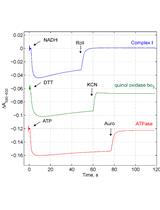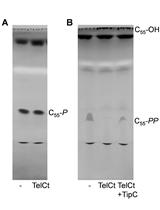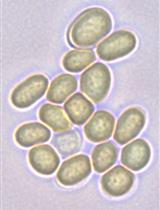- EN - English
- CN - 中文
Crude Preparation of Lipopolysaccharide from Helicobacter pylori for Silver Staining and Western Blot
粗制备幽门螺杆菌脂多糖用于银染和蛋白质印迹
发布: 2017年10月20日第7卷第20期 DOI: 10.21769/BioProtoc.2585 浏览次数: 10639
评审: Andrea PuharAnonymous reviewer(s)
Abstract
This protocol provides an easy and rapid method to prepare lipopolysaccharide from the gastric pathogen Helicobacter pylori for visualization on acrylamide gels by silver staining and for detecting the presence of Lewis antigens by Western blot. The silver staining is a four-step procedure, involving a 20 min-oxidation step, a 10 min-silver staining step, a 2-10 min color development step and finally a 1-min color termination step. Lipopolysaccharide from H. pylori wild-type and corresponding mutants analyzed by this method are described in a recent publication (Li et al., 2017). This crude preparation of LPS for silver staining is also applicable in other Gram-negative bacteria.
Keywords: Lipopolysaccharide (脂多糖)Background
Lipopolysaccharide (LPS) is a large and variable complex glycolipid that makes up the outer leaflet of the outer membranes of most Gram-negative bacteria. It is typically composed of three domains: a hydrophobic domain termed lipid A (or endotoxin), which is embedded in the outer membrane; a relatively conserved non-repeating core-oligosaccharide; and a variable O-antigen, which extends from the cell to the external environment. A unique feature of H. pylori lipopolysaccharide O-antigen is the presence of fucosylated oligosaccharide structures that mimic human Lewis antigens. Large-scale extraction of highly pure LPS from Gram-negative bacteria is labor-intensive and time-consuming. Here, in this protocol, we describe in detail the use of an easy and rapid crude preparation of LPS from the gastric pathogen Helicobacter pylori for visualization by silver staining and Lewis antigen expression by Western blot.
Materials and Reagents
- Pipette tips
- Inoculating loops (10 μl) (Copan Diagnostics, catalog number: 8177CS20H )
- Aluminum foil
- PVDF membrane (0.2 μm) (Merck, catalog number: ISEQ00010 )
- H. pylori cells
- Columbia blood agar (CBA) plates (Autobio Diagnostics, catalog number: M0109-2 )
- Sodium chloride (NaCl) (Sigma-Aldrich, catalog number: 746398-500G )
- Potassium chloride (KCl) (Sigma-Aldrich, catalog number: 746436-500G )
- Sodium phosphate dibasic (Na2HPO4) (Sigma-Aldrich, catalog number: 795410-500G )
- Potassium phosphate dibasic (K2HPO4) (Sigma-Aldrich, catalog number: 795496-500G )
- NaOH (Sigma-Aldrich, catalog number: S5881-500G )
- Proteinase K (Sigma-Aldrich, catalog number: P8044-1G )
- Ethanol (Sigma-Aldrich, catalog number: 24102-5L-R )
- SDS (Sigma-Aldrich, catalog number: L3771-1KG )
- Glycerol (Sigma-Aldrich, catalog number: G9012-1L )
- Tris base (Sigma-Aldrich, Roche Diagnostics, catalog number: 11814273001 )
- Glycine (Sigma-Aldrich, catalog number: G8898-1KG )
- Bromphenol blue (AMRESCO, catalog number: 0449-50G )
- β-Mercaptoethanol (AMRESCO, catalog number: 0482-100ML )
- Periodic acid (Sigma-Aldrich, catalog number: P7875 )
- Acetic acid (BDH, catalog number: 100015N )
- Ammonium persulfate (Sigma-Aldrich, catalog number: A3678 )
- Ammonium hydroxide (Sigma-Aldrich, catalog number: 320145 )
- Silver nitrate (Sigma-Aldrich, catalog number: 209139 )
- Citric acid (Sigma-Aldrich, catalog number: C7129 )
- Formalin (37% formaldehyde) (Sigma-Aldrich, catalog number: 252549 )
- Freshly-made 15% SDS-PAGE gels
- 30% Acrylamide/Bis (Bio-Rad Laboratories, catalog number: 1610157 )
- TEMED (Bio-Rad Laboratories, catalog number: 1610801 )
- Methanol (Sigma-Aldrich, catalog number: 34860-4X4L-R )
- Bovine serum albumin (BSA) (AMRESCO, catalog number: 0332-100G )
- Tween-20 (Solarbio, catalog number: T8220-500 ml )
- Mouse anti-Lex (Santa Cruz Biotechnology, catalog number: sc-59471 )
- Mouse anti-Ley (Santa Cruz Biotechnology, catalog number: sc-59472 )
- Mouse anti-Lea (Santa Cruz Biotechnology, catalog number: sc-51512 )
- Mouse anti-Leb (Santa Cruz Biotechnology, catalog number: sc-51513 )
- Secondary rabbit anti-mouse peroxidase-conjugated IgM antibody (Jackson ImmunoResearch Laboratories, catalog number: 315-035-049 )
- Chemiluminescent peroxidase substrate-1 (Sigma-Aldrich, catalog number: CPS1120 )
- PBS (pH 7.2) (10x) (see Recipes)
- SDS-PAGE running buffer (10x, see Recipes)
- 0.1 N NaOH solution (see Recipes)
- LPS lysis buffer (see Recipes)
- Oxidation solution (see Recipes)
- Silver staining solution (see Recipes)
- Color developer solution (see Recipes)
- Termination solution (see Recipes)
- SDS-PAGE transfer buffer (10x, see Recipes)
- TBS (10x, see Recipes)
Equipment
- Pipettes (Eppendorf, catalog numbers: 4920000024 , 4920000059 , 4920000067 , 4920000083 )
- Centrifuges (Eppendorf, catalog number: 5418 R )
- Glass wares
- Water bath
- Rotary shaker
- Cell electrophoresis tank (Bio-Rad Laboratories, catalog number: 1658001 )
- Electrophoresis power supply (Bio-Rad Laboratories, catalog number: 1645070 )
- Semi-dry electrophoretic transfer system (Bio-Rad Laboratories, catalog number: 1703940 )
- pH meter
- Spectrophotometer (Shimadzu, model: UV-1601 UV-Visible)
- Digital camera
- Luminescent Image Analyzer (Fujifilm, model: LAS-3000 )
Software
- Image reader LAS 3000 V2.2
Procedure
文章信息
版权信息
© 2017 The Authors; exclusive licensee Bio-protocol LLC.
如何引用
Li, H. and Benghezal, M. (2017). Crude Preparation of Lipopolysaccharide from Helicobacter pylori for Silver Staining and Western Blot. Bio-protocol 7(20): e2585. DOI: 10.21769/BioProtoc.2585.
分类
微生物学 > 微生物生物化学 > 脂质
生物化学 > 脂质 > 脂质分离
您对这篇实验方法有问题吗?
在此处发布您的问题,我们将邀请本文作者来回答。同时,我们会将您的问题发布到Bio-protocol Exchange,以便寻求社区成员的帮助。
Share
Bluesky
X
Copy link













